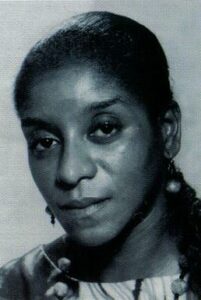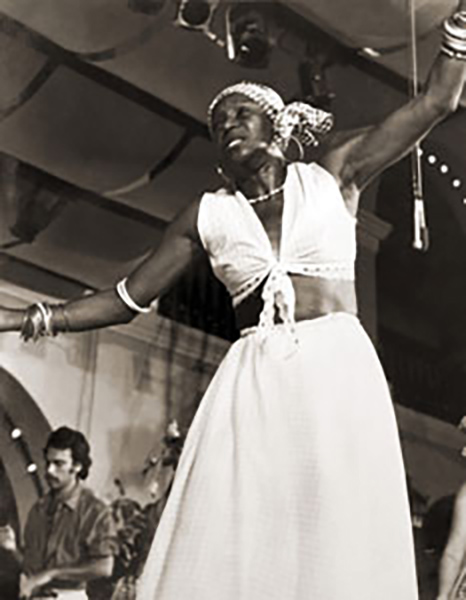For over thirty years Sylvia Luz del Villard Güilbert gave global lectures and performances on the African influence in Puerto Rico (PR) as an activist, actress, artist, ballerina, choreographer, coloratura, dancer, declamadora, folklorist, lecturer, orator, painter, teacher, singer, and writer. Reared by Paula Moreno Herrera, she was born February 28, 1928 in Santurce, PR to Ponce-native Marcolina Güilbert and Arecibo-native Agustín Villard Díaz (1897-1986). Villard graduated from Escuela Superior Central, won a PR government scholarship, briefly attended Fisk University, and ultimately completed University of Puerto Rico–Río Piedras B.A. and M.A. degrees.
In the 1950s, Russian Jewish pianist Sonia Rudd (formerly Sonya Rudenko) and Metropolitan Opera House voice coach Leo Braun trained Villard while she attended CUNY. She joined the Africa House troupe, and became a member of Carabalí Dancers (with Christine Chapman and Roland Duvall Davis). She adapted African dances to poetry, performed Afro-Antillean and Negro Spirituals at Café Teatro Ocho Puertas (1963) and at the 1979 Pan-American Association Festival of the New World in Lagos. While in Nigeria she engaged in genealogy research on her possible lineage within the Igbo and Yoruba.

Fair use image
Villard founded Teatro Afro-Boricua El Coquí (1968), Luis Palés Matos Theater (1977), and headed Ensemble Soninke, while playing roles in El Reto, Gri-Gri, Baquiné, Aquelarre y Tambó, Let My People Go, El Negro en América; choreographed for the Afro-Borcua Ballet and Compañía Asociación Latinoamericana de Cultura; and danced in Palesiana y Aquelarre, Palesíanisima, Valley Without Echo, Witches of Salem, The Boy Friend, The Crucible, and Kwamina. Her many film credits include Los Traidores de San Ángel, The Time We Lost, and Life of Sin.
Villard’s artistry collided with PR anti-Blackness when the television industry shunned her for publicly condemning Angela Mayer’s blackface Chianita La Negra in El Hijo de Ángela María (1974). PR whites in blackface was “repulsive,” Villard asserted, and Blacks were “tired of this situation.” In the late 1970s, Viejo San Juan residents deemed her African-centered productions as disruptive and promoted years of costly court battles to have her theatre closed. Villard experienced racist taunts by unruly Bayamón teens for her Luis Palés Matos high school performance (1980-81). This unapologetic Blackness inspired many Afro-Puerto Ricans like writer María Ramos Rosado, dancer Awilda Sterling-Duprey, actor Julio Axel Landrón, percussionist ‘Papo’ Sterling and musician Jorge Santiago Arce.
In 1988, Villard taught in New York City and the following year she presented “Racism in the Puerto Rican Nation” in the Black Woman in the Americas symposium at the Schomburg Center for Research in Black Culture. Diagnosed with lung cancer soon after, she returned to PR where she died at 62 on February 5, 1990. Despite Governor Hernández Colón infamously dismissing the African contribution to PR culture, he nevertheless paid last respects when visiting Villard’s childhood home. Survived by daughter, Naii Luz Colón and buried in the Villa Palmeras Cemetery near Black legends Rafael Cortijo and Ismael Rivera, Queen Mother Sylvia del Villard, journalist Wilda Rodríguez declared, “lived her life protecting our African heritage and she did it with extraordinary passion. She was a Black Queen to those of us who had the privilege of paying her tribute.”

